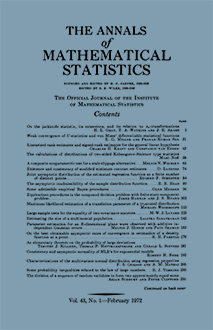Abstract
We consider here another aspect of a problem mentioned in a previous paper [2]. We shall be concerned with one-dimensional, real-valued random functions (r.f.) $X(t)$, defined for all $t$ and such that any sample taken at equidistant $t$-points satisfies a linear relation which is an analogue of one or other of the stochastic difference relations which are used for the analysis of discrete-parameter time-series. More specifically, we assume that there exist $k$ continuous and real-valued functions $\alpha_1(h), \cdots, \alpha_k(h) \text{of} h \geqq 0$ such that for any $h > 0$ and any $t$, the sequence \begin{equation*}\tag{1}\{X(t + \lbrack n + k \rbrack h) + \alpha_1(h)X(t + \lbrack n + k - 1 \rbrack h) + \cdots + \alpha_k(h)X(t + nh)\}, n = 0, \pm 1, \cdots,\end{equation*} satisfies certain conditions about independence or noncorrelation. In Section 1, we consider hypotheses concerning correlation, and find that the functions $\alpha_j(h)$ are restricted to certain forms. We also find that the assumption of zero serial correlations in the sequence (1) for all $h > 0$ implies that $X(t)$ is deterministic. In Section 2, we consider hypotheses concerning independence, and find the functions $\alpha_j(h)$ to be restricted as before.
Citation
S. G. Ghurye. "Random Functions Satisfying Certain Linear Relations, II." Ann. Math. Statist. 26 (1) 105 - 111, March, 1955. https://doi.org/10.1214/aoms/1177728597
Information





